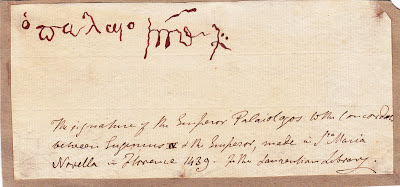How di Martoni would probably have appeared.
Western merchants, fresco detail ca. 1400,
Western merchants, fresco detail ca. 1400,
Ag. Paraskevi, Halkis/Negroponte
A recent entry concerned Negroponte and Evliya's 1668 account of the channel for the mill wheels. Pierre MacKay, working on evidence for the channel, became charmed by the 1395 visit of Nicola di Martoni who also noted the mill wheels.
Di Martoni, returning to Italy from the Holy Land, stopped at Negroponte, Athens, and Corinth -- the last two at singularly important dates in their medieval history. He was a notary, married, the father of two children who had died prematurely. He was, as he says below, stuck in Negroponte for forty days, hoping for a galley that would take him back to Italy.
* * * * * *
The island of Negropont is 300 miles around and is separated from the mainland by an arm of the sea some XII passus wide or a little more. The city of Negropont is built at the extreme corner of this island near that arm of the sea and is smaller than the city of Suesse,1 but is well populated with Latins and Greeks. The island has many fortresses and towns and a population of 14 thousand households.2 The largest church in the city is called the church of St Mary3 and is quite beautiful. In other ages the city was three times as large, but was ruined by wars. Now it is confined to one place close to the afore-mentioned arm of the sea. Outside the city are various dwellings and ancient buildings among which is the priory of St. Francis. which is a fine large place where the friars live from their own produce. The wardens of this place say that its annual revenue is about a thousand ducats. Not far away from here is a convent of nuns which is called Santa Clara.
The ancient castle: In this arm of the sea which separates rhe island from the mainland there is a certain large and ancient building which thay say was the castle of Fata Morgana, the Lady of the Lake, and the mother of Pozella Gaza, and they say that Lord Calvano was held captive in this castle.4
The bridges: On this arm of the sea, there are two bridges made of wood, one on either side of the castle, and the men who travel back and forth by land, whether towards the mainland or the island of Negropont pass over these bridges and through this same castle, and armed men are assigned to stand diligently on guard over these bridges and the gateways. The water in this arm of the sea flows continually, like a river, sometimes from the one harbor and sometimes from the other, for there are two harbors for ships here.
The mills: In the said stream there are three mills, cleverly made so that they grind grain, whichever way the current flows. The revenue of these is about fifty ducats annually.5 On occasion, the current in this stream flows so violently that the wheels of the mills are smashed. The city itself is strongly surrounded by the sea on three sides and has fine walls and many towers encircling it. It has many well-bred and wealthy men, as well as beautiful women. I think that they are the descendants of the enchantresses who lived in the ancient castle. They are in general distinguished by great beauty and wear fine clothing in the Italian style.
We waited forty days for the ship that was to come from Venice, feeling great anxiety in moth mind and heart, but had no news of her arrival. Finally, on the advice of the bailo, we accepted some letters of recommendation from him and set out to return to Athens, so as to seek a return voyage home from there.
(Translation: Pierre MacKay. More from di Martoni later. Meanwhile, the Latin text of his travels can be downloaded here.)
1 Suesse is Sessa Aurunca, northwest of Naples. Di Martoni compares everything to home.
2 This would mean an island population of 58,000 which is not at all likely.
3 SS Mary and Dominic: the Dominican priory church, now Ag. Paraskevi.
4 The names come from the northern Italian Arthurian tradition.
Despite the mosque and contemporary buildings, this 1890s photograph of
Negroponte gives a sense of the fortress, city, and great Dominican church
that di Martoni saw. The towers and gate were rebuilt in the 15th C.
Negroponte gives a sense of the fortress, city, and great Dominican church
that di Martoni saw. The towers and gate were rebuilt in the 15th C.

























